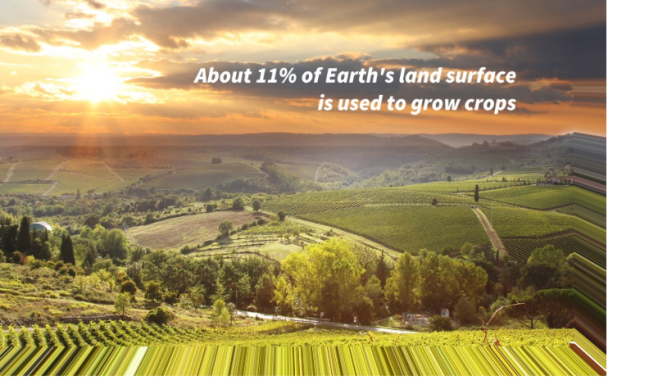Uncategorized
Time Bomb: Corporate prostitution Hits Alarming Levels in Uganda
HIV/AIDS activists have quoted a new type of prostitution they term as “corporate prostitution”, where prostitutes do not line up on the streets, but have built a network of customers and have managers and a client list.
They say it is on the rise in Uganda and is crippling the fight against HIV.

AIDS activist Margaret Happy says : “They (corporate prostitutes) even have brokers who connect them to potential customers. And customers pay good money.”
The activists say complacency in behaviour is hampering the fight against the virus.
At a function organised by Childbirth Survival International (CSI) and Mildmay Uganda in Wakiso district, Rosemary Ssenyondo, a marriage counsellor with CSI, said:
“There is a lot of naivety among our girls. I do not know what causes it, but some girls who have completed university do not want to work. They want free things so they sleep with older, rich men. This is a big problem.”
She said such behaviour is contributing greatly to the spread of the virus.
According to latest UN Joint Programme on HIV/ AIDS (UNAIDS) statistics, Uganda is among the 15 countries contributing 75% of new infections in the world. The country is second in Africa, with South Africa contributing the most new infections while Nigeria comes in the third position.
Source: The New Vision.
Environmental Degradation- Buhweju’s Visible ‘Benefit’ From Gold Mining

For over 50 years now, Buhweju has been mining gold- one of the precious minerals in the world. However, this western Uganda mountainous district is still grappling with poverty and poor social services as gold continues to ‘flow’ from this area.
I took a weeklong trip to this relatively new district to establish the contribution of the mining industry to the local government economy.
Inside Buhweju
Buhweju district has eight sub counties and half of them have huge gold deposits. Nine companies are today operating in this area but all the nine gold dealing companies have prospecting licenses.
As the name of the license type suggests, these companies are involved in assessing the gold potential of the district. As the licensed companies go on with their work, the small scale individual gold miners are also busy looking for livelihood from the ground.
In 2013, the Ugandan president directed that these small scale miners should stop but this fell on deaf ears.

Unlike in Tanzania (Geita District) where gold mining is in the highlands, gold mining in Buhweju is in swampy areas- something that raises key environmental worries.
On my trip I first stopped in Bisya Sub County and the area is Bukoto village where a wetland is steadily vanishing as hundreds of energetic men and women search for gold.
Every morning these people come to this swamp to mine gold. With their rudimentary tools, they dig -some as deep as 8-12 metres to extract sand which they sieve to get gold.
“I come here every day to look for money. Using my hoe and spade, I dig the ground to extract the sand where I get gold from. Sometimes the sand is too deep in some areas so I dig much deeper”, a determined Byarugaba Alexander of Bukoto Village told me.

However, not every day is good for Byarugaba and his colleagues. Richard Matsiko, a miner in Bukoto’s neighboring gold mining village of Kyenjogyera told me that it’s not surprising digging the whole day and one fails to get anything. “Sometimes we work the whole day and fail to get anything but we must go on the next day”, he explained.
Apart from failure to earn a penny, these determined Ugandans have to also cope with flooding of their mining area since it’s a swamp, ‘harassment’ from Environmental officers, fluctuating gold prices as offered by the local dealers in the area as well as unfriendly weather conditions during the rainy season. Despite all these hardships, those involved in the industry are happy with the way things are moving as they have been able to earn a living from the trade.
District laments gold money loss
Local miners are smiling on one hand as district leaders lament over the little contribution of the gold mining industry to the economy of the area.
According to the district chairperson Sebastian Kerere, the district does not get taxes from the gold dealing companies operating in the area neither are they engaged in any activity as part of their corporate social responsibility.
“These companies are not giving us any money because they are only prospecting according to their licenses. They are also not involved in any pro-society act like road construction yet they use the district infrastructures. I can honestly say that as a district, we get nothing from them and from our gold”, he elaborated.

A visibly unhappy Kerere explains that the licenses given to these companies ought to be clear to the district. “We are not getting any money from these companies because they claim to be prospecting in our district. What is unclear to us is where they take the gold they get in the process of prospecting. If we knew the amount of gold they get, we would be in position to levy something like a tax on them” a worried Karere elaborated adding that government ought to explain the duration of the prospection and the handling of the resource got in the process.
Other leaders also agree with the district chairman on this. Alison Ayetoranire Byamukama, the Special Presidential assistant on Buhweju affairs wants government to revise the current law on mining to allow local governments to have an extended say on licenses, production and sharing of the benefits rather than all these powers remaining at the responsible Ministry level.

In every mining area I visited, over 70 percent of the miners were energetic young men of school going age. Olive Koyekyenga, the district Woman Member of Parliament says that many youngsters have abandoned schooling to join the gold mining industry where they get ‘quick’ money.
“We have high illiteracy levels here because our children abandon school to join the mining industry. These young energetic youth should be the one involved in agriculture but this sector has been left to the old people. This is a bad trend that must be checked for the good of the future of this country” Mary Bashongoka- the district council speaker explained.
What the district has got from gold
Apart from providing a source of income to hundreds, in the financial year 2011/2012, Buhweju district got four million shillings (about 1600 US dollars) from government as its share from the resource.
“Yes we got this money but we are asking ourselves, this is a portion of what/how much? This is too little money and cannot do anything tangible in this vast district of ours” Kerere, the district chairman noted while speaking to me at the district headquarters in Nsika town. This amount is far less than one percent of the district’s 2013/2014 financial year budget. For the last (2012/2013) financial year, Karere notes that they are yet to get any penny from the government.
Perhaps this explains why Buhweju still has many infrastructural problems like poor roads, poor hospitals, poor schools, poor electricity coverage as well as a big portion of the district population without access to clean gravity water.
Compared to other gold rich districts with in the East African, region, one sympathizes with Buhweju leaders when they cry of injustice.

For example, in August 2013, when I and fellow journalist under the Revenue watch Institute oil gas and mining fellowship visited Geita district in Northern Tanzania, the district commissioner Manzie Mangochie told us that Geita gold mining company which extracts gold from the area was paying 200,000 Dollars as loyalty yet according to him, this is peanuts.
According to the Buhweju Member of parliament Ephraim Biraro, all hope is not lost and the district is optimistic that once something changes, the area will benefit more.

“First of all there is a need to review the current mining laws so that we also get a say on the management of our resource. We need to know who is doing what here and also we ought to be aware of how much gold comes from our land. If this happens, we will be able to know how much is our share and how we stand to benefit from the companies operating from our area”, Biraro elaborated during a lengthy chat with him at his Parliamentary office in Kampala.
One issue that is of concern to many people in Buhweju is about the companies in the area that are prospecting. The Buhweju district council speaker Mary Bashongoka wants more transparency in the operation of these companies. “We want to know what these companies are doing, how they are doing it, what they are getting from our land, where they put the gold they get in the process and how do we benefit” Bashongoka observed adding that the companies in the area are involved in mining gold yet they do not pay taxes. This claim was raised by the local miners in all the sub counties I visited but all the companies operating in the area say they are only involved in gold prospecting.
According to the Department of Geological Survey and Mines in Ministry of Energy and Mineral Development In order to participate in mineral exploration, one must acquire a Prospecting License. The license is area specific and gives authority to the holder to look for mineral occurrence of interest in Uganda, and then demarcate it. This helps to make others aware that the area is exclusively booked and nobody else should go in. The Prospecting License is not renewable and lasts only one year from date of issue.
Environmental concerns
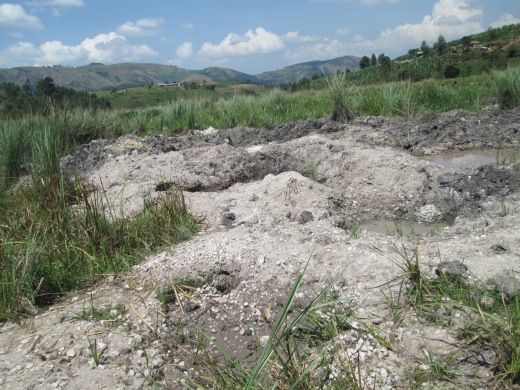
Like any other mining area on the continent, Buhweju is facing serious environmental concerns as a result of the ongoing gold mining activities. Swamps have been destroyed as a result of the open cast mining method and it seems little is being done to halt this trend.
In fact miners at Nyakishana, Bukoto, Bihanga and Kyenjogyera swamps told me that they rarely see environmental officers ‘interfering’ with their work.
They told me that they have an understanding with environmental authorities that they will always cover the pits they dig in the mining process to minimise on the damage to the natural swamp eco-system.
However this is not the case. When I went to Bihanga, I visited a swamp that was used by miners almost two years ago but the open pits can still be seen and the vegetation has not recovered.

When I asked those involved, they confessed that what is on the ground is the opposite of what was agreed upon. “Yes, we are supposed to cover our pits but most of us do not follow this and no one is there to enforce it”, Kakuru Everist one of the miners in one of the swamps in Bihanga sub county told this site.


According to the National Environmental Management Authority (NEMA) there should be an environmentally friendly mining. “We need the two resources. “As we do mining, we must also protect the environment for today, tomorrow and for the generations to come”, Jeconious Musingwire, a NEMA officer notes.

By Cliff Abenaitwe- 2013/2014 Revenue watch and ACME Oil Gas and Mining fellow
NIGHT WORK BAD FOR THE BODY
Doing the night shift throws the body “into chaos” and could cause long-term damage, warn researchers. Shift work has been linked to higher rates of type 2 diabetes, heart attacks and cancer.
Now scientists at the Sleep Research Centre in Surrey have uncovered the disruption shift work causes at the deepest molecular level. Experts said the scale, speed and severity of damage caused by being awake at night was a surprise. The human body has its own natural rhythm or body clock tuned to sleep at night and be active during the day. It has profound effects on the body, altering everything from hormones and body temperature to athletic ability, mood and brain function.
The study, published in Proceedings of the National Academy of Sciences, followed 22 people as their body was shifted from a normal pattern to that of a night-shift worker. Blood tests showed that normally 6% of genes – the instructions contained in DNA – were precisely timed to be more or less active at specific times of the day. Once the volunteers were working through the night, that genetic fine-tuning was lost. Chrono-chaos “Over 97% of rhythmic genes become out of sync with mistimed sleep and this really explains why we feel so bad during jet lag, or if we have to work irregular shifts,” said Dr Simon Archer, one of the researchers at the University of Surrey.
Fellow researcher Prof Derk-Jan Dijk said every tissue in the body had its own daily rhythm, but with shifts that was lost with the heart running to a different time to the kidneys running to a different time to the brain. He told the BBC: “It’s chrono-chaos. It’s like living in a house.
There’s a clock in every room in the house and in all of those rooms those clocks are now disrupted, which of course leads to chaos in the household.” Studies have shown that shift workers getting too little sleep at the wrong time of day may be increasing their risk of type-2 diabetes and obesity. Others analyses suggest heart attacks are more common in night workers. Prof Dijk added: “We of course know that shift work and jet lag is associated with negative side effects and health consequences. “They show up after several years of shift work.
We believe these changes in rhythmic patterns of gene expression are likely to be related to some of those long-term health consequences.” Prof Hugh Piggins, a body-clock researcher from the University of Manchester, told the BBC: “The study indicated that the acute effects are quite severe.
This story was written by BBC’s James Gallagher
Light at the end of the tunnel as Sperm test for infertile men could reduce surgery
Light at the end of the tunnel as Sperm test for infertile men could reduce surgery
 Scientists have developed a non-invasive test that can predict whether men with zero sperm counts are capable of fathering children through IVF.
Scientists have developed a non-invasive test that can predict whether men with zero sperm counts are capable of fathering children through IVF.
Current methods rely on surgery to find out if a man has viable sperm that can be retrieved for fertility treatment.
The research, in Science Translational Medicine, suggests two biomarkers can identify who will benefit from surgery.
A UK fertility expert said the test, which will take at least a year to bring to the clinic, was “encouraging”.
Male infertility is responsible for about half of cases of infertility.
Men who produce no sperm can sometimes be helped to father a biological child through fertility treatment if they have normal sperm that can be extracted surgically.
Others will never be able to father a child naturally and need to use donor sperm.
The fact that two protein markers present in semen can be so well correlated with whether sperm are likely to be found is very encouraging indeed”
Dr Allan Pacey University of Sheffield
With current technology, the only way to find out if a man has viable sperm is to carry out surgery to look for sperm in the testes.
The new test, developed by scientists in Canada, has identified two biomarkers in sperm, which can be used to predict whether sperm retrieval will be successful.
Dr Keith Jarvi of the Lunenfeld-Tanenbaum Research Institute, Mount Sinai Hospital in Toronto, Canada, said the holy grail of his research was to find a way to help men avoid unnecessary testicular biopsies.
He told BBC News: “The benefit of this is that we can predict without surgery whether or not a man has sperm or does not have sperm in the testicles.
“You could avoid unnecessary surgery for a number of these men.”
From BBC
He said work was under way to adapt the test for use in fertility clinics.
“Optimistically, it would be a year away,” he added. “Pessimistically, two years – we’re moving along really quickly.”
Dr Allan Pacey, senior lecturer in andrology at the University of Sheffield and chairman of the British Fertility Society, said the diagnosis of male infertility was tricky and it was hard to determine whether a man was producing sperm or not.
The conventional method was to first examine semen under a microscope to see if sperm was there, he said.
If no sperm was seen, the next step was to take tissue from a man’s testicle and examine it with a microscope.
“Quite understandably, many men would rather not undergo this procedure if they didn’t have to,” said Dr Pacey.
“Therefore, having an accurate biochemical test which might help doctors advise men whether taking a piece of the testicle is worth doing or not, would be very useful.
“It could help men make better decisions, avoid unnecessary surgical procedures and potentially help save money by not having to do surgical procedures that aren’t needed.
“The fact that two protein markers present in semen can be so well correlated with whether sperm are likely to be found is very encouraging indeed.”
The Gold- Poverty Paradox of Geita- An Inside Story
By Abenaitwe Cliff
At the mention of Gold presence in an area, wealth expectations justifiably increase and when its mining is on, the area ought to change for the better. However, the story is different in Geita district located in the North Western part of Tanzania where gold mining has been taking place for over 50 years now.
Poor sanitary conditions, shanty dusty towns and trading centres, use of rudimentary tools, high population growth rate, high rate of rural urban migration, high number of idle youth and poor sanitation are a characteristic of Geita district located over 700 kilometres North of the capital Dar es Salaam.
In 1999, Angro-Gold Ashanti(GGM as it is popularly known)- a giant mining company got a license to mine gold the area something that gave the residents most of whom were engaged in small scale mining hope for a brighter future. “When GGM came in, we thought large scale well managed gold production will increase and the whole area will develop,” says Barutwanayo Bernard, a native of Nyakabale in Geita district.
According to Baruntwanayo, the residents expected the company to provide them with jobs, contribute to the social welfare of the area through it taxes, fees and loyalties but this is still a dream after over 10 years.
On reaching the district’s main town of Geita, the streets are dusty, the schools along the road are in a poor state, people live in poor houses and a big number of youth can be seen on the streets idle as early as noon. “Our lives have not changed at all. I have tried to get a job in the mines but all in vain and this is the same situation with all my friends. If you do not know anyone in the mines or if you do not have money to bribe, you cannot get a job there”, a visibly worried young man Baraka Butundo noted adding that the mine owners usually get their own laborers from as far as Dar es Salaam.
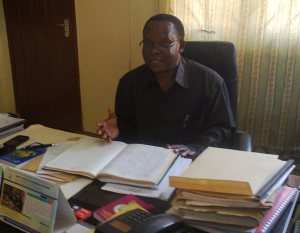
Authorities in this relatively new district share the same view. Manzie Mangochie the District Commissioner reveals that the mining company pays only 200,000 dollars annually as loyalty fee to the district a figure which is like a drop in the ocean. “This money is little compared to the population, the size of the district and the needs of our people,” Mangochie told a group of journalist under the revenue watch program at his office in Geita town.
According to the jolly Mangochie, much as GGM pays taxes to the government, its direct relevance to the area is still a dream.
Though the situation is not desirable something can be done on the legislative front. “We need to change on the laws concerning the mining sector. There is a need to empower local leaders and communities to have a say in mining contracts because it’s their areas to gain or lose,” he elaborated.

These photos were taken from different areas of Geita district to show the situation on the ground.












Crimean–Congo Hemorrhagic Fever: Uganda Government in For Mass Tick Spray in Agago
Crimean–Congo Hemorrhagic Fever: Uganda Government in For Mass Tick Spray in Agago
Cliff Abenaitwe, September 2, 2013
Government is to roll out a massive spray against ticks in Agago district as the fight against the deadly Crimean Congo fever intensifies.
According to the Ministry of Health Permanent Secretary Doctor Asuman Lukwago, the Ministry is working with the Veterinary Department of the Ministry of Agriculture to roll out the campaign but does not reveal when this will kick-start. “What we found so unique in Agago is the high level of tick infestation. We are now working with the Veterinary Department of the Ministry of Agriculture and other stake holders to organize a spray,” Lukwago told this site in an exclusive interview adding that even President Yoweri Museveni has already made a directive on the new ways of controlling ticks.
He explained that it has been discovered ticks tend to develop resistance against acaracides (animal sprays) when a farmer uses one type over a long time. “This information was not known that acaracides have a span of activity which is about three years so it is now advised that after three years, a farmer should change the acaracide type,” Lukwago said.
Despite the above arrangements, Lukwago is also confident that the outbreak will be contained. “The situation is under control. We have only three cases in the country. One confirmed positive person is admitted at Mulago hospital while two other are under surveillance at Kalongo hospital in Agago district” he explained.
Early last month (August), the Ugandan Ministry of Health confirmed the outbreak of the Crimean–Congo hemorrhagic fever in Amot Sub-County, Agago district. Since then, one person has died and surveillance has been heightened.
The disease is caused by a tick-borne virus (Nairo-Virus) which causes severe haemorrhagic fever and kills up to 40 percent of people infected. It is spread by wild and domestic animals and is transmitted to humans through bites of infected ticks.
According to World Health Organization and Ministry of Health, a person who is infected with the disease may present with headache, high fever, back pain, joint muscle pain and bleeding from body parts. Other signs and symptoms may include stomach ache, red eyes, red throat and vomiting.
Much as most of these signs resemble those of Ebola which once claimed scores in Uganda, health experts and organisations say the two viral diseases are different.
Panic as New Banana Disease Sweeps the Tropics
By- Cliff Abenaitwe
Uganda has been put on alert by reports of a deadly viral banana disease- Banana bunchy top disease (BBT) in the neighboring countries. The disease has already wreaked havoc in Eastern Congo, some parts of Rwanda and it also reported in Burundi.
According to Doctor Fen Beed,(right)  a pathologist with the International Institute of Tropical Agriculture (IITA) based in Dar es Salaam, this dangerous disease is in Eastern Democratic republic of Congo and in the neighboring Rwanda; not far away from Uganda. According to Fen, this disease viral disease attacks and completely destroys all banana varieties and is transmitted by aphids.
a pathologist with the International Institute of Tropical Agriculture (IITA) based in Dar es Salaam, this dangerous disease is in Eastern Democratic republic of Congo and in the neighboring Rwanda; not far away from Uganda. According to Fen, this disease viral disease attacks and completely destroys all banana varieties and is transmitted by aphids.
This disease is spread through plant materials like Matooke, banana suckers or other banana materials when transported from an infected area to another. “It is this mode of spread that puts the neighboring countries at risk. That is why we are on alert and ready,” Doctor Kephas Nowakunda a research officer with the national banana research program at the National agricultural Research organization (NARO) explains.
Scientists say that this disease is as deadly as the viral banana bacterial wilt which has already destroyed thousands of acres of banana plantations in Uganda.
Doctor Nowakunda reveals that following reports of this disease outbreak in Congo and Rwanda, Uganda has been on alert. “After this disease was reported in DRC and Rwanda, we dispatched a team of scientists to monitor our borders. The team discovered that the disease is not yet in Ugandan and since then, we are closely monitoring the situation,” he explains.
According to Doctor Nowakunda this disease is easy to recognize once it attacks your plantation. “Every vigilant farmer can recognize this disease. It makes the leaves stunted, they become yellow especially along the edge, and the plant becomes stunted,” the researcher elaborates.
With the possibility of this disease spreading to Uganda, farmers in banana rich western part of the country are now having sleepless nights after witnessing the destruction of their plantations by another viral disease -Banana Bacterial wilt.
Doctor Charles Lagu, scientists with the Mbarara zonal agricultural institute says that farmers must adopt improved disease resistant yet quick maturing banana varieties or stand to witness the demise of their income and food source.
NARO- the principal research organization in Uganda has already developed banana types like M20, M9, and M21 which mature fast, are disease resistant and they give high yields while trials for genetically modified varieties are in advanced stages.
Bio-Science key to Achieving MDG1 in Africa
Aside Posted on Updated on
Bio-Science key to Achieving MDG1 in Africa
Cliff Abenaitwe
African countries have a long way to go if they are to achieve the
millennium development goal one (MDG1) of halving by 2015 the
proportion of people suffering from extreme hunger and poverty.
Less than 3 years to the deadline, the continent is still synonymous
with millions living below the poverty line and it is still affected
by hunger which seems to be going nowhere.
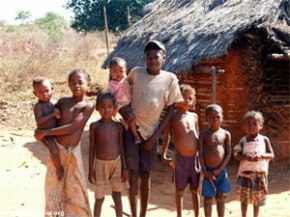
According to the UN food and agriculture 2010-2011, sub Saharan Africa is home to 26 percent of the world’s undernourished population, has the highest number of countries experiencing food emergencies due to in part, to climate extremes such as drought and exacerbated by civil unrest. The same reports reveals that Sub Saharan African still experiences increased food imports and is very vulnerable to global food price increases.
Experts attribute this trend to the poor performance of the agricultural sector.
The academy of science of South Africa (ASSAF) in its 2012 regulation
of agricultural GM technology in Africa report reveals that the poor
performance of the agricultural sector undermines Africa’s prospects
of attaining the MDGs and sustainable development in general. “The low agricultural productivity is associated with a wider range of
factors, including low investments in education, infrastructure,
research and development and over reliance on convectional technologies”, the report explains.
The solution for Africa is to improve the performance of the
agricultural sector.
However this report warns that much as the application of the best
conventional agricultural technologies can make significant
contribution to improving food security, it is not sufficient in
itself. “ The expansion of cultivated land through mechanization and provision of fertilizers can make a positive impact on food security in Africa but further benefits can be achieved by the application of modern biotechnology methods to plant improvement programs, principally for the so-called ‘orphan crops’ of particular importance to Africa”, the
report suggests.
According to Doctor Fen Beed, a pathologist from the USA who has worked in Uganda, Tanzania, Malawi and Ghana, it would be surprising if Africa met the MDG1 by 2015 but according to him, this can be achieved in years to come.“If African countries can adopt bio-technology and other good farming practices, poverty and hunger can be reduced but this will be after 2015,” he added.

Other scientists also agree with Doctor Beed on the role of bio-technology in agricultural improvement in Africa.
In the book Insights; Africa’s future.. can bioscience contribute?, Calestous Juma, a world renown scientist argues that African agriculture will need to intensify the use of science and technology more than would have been the case without the threats of climate change. “Investment in science and technology will be required along the entire agricultural value chain from resource intelligence through production, marketing, storage and ecological rehabilitation,” he explains.
Synonymous with what the researchers are recommending, African countries are making commendable progress in the use of Bio-science.
At Mukono zonal agricultural research and development institute research into improved crop species is under way and the institute has already developed improved fruit varieties. “The breeds we are developing as a result of grafting and cross breeding are disease resistant, quick maturing and high yielding,” Robinah Gafabusa, a fruits and vegetables research technician at this institute explains.
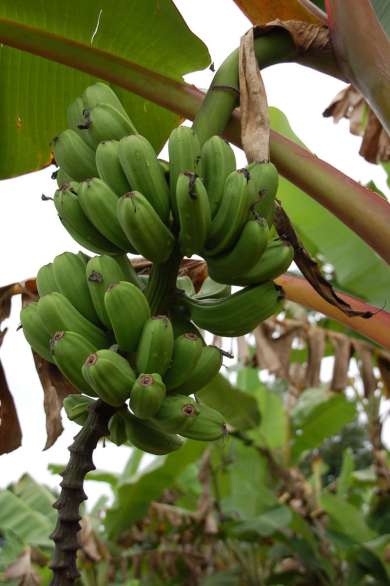
At the National research Organization NARO, researchers are developing different crop varieties to help farmers cope with the problem of diseases and low yields. According to Tendo Sali Lauben, a crop breeder at NARO, they have already developed banana varieties like M20, M9, M21 which mature fast, are disease resistant and they give high yields.
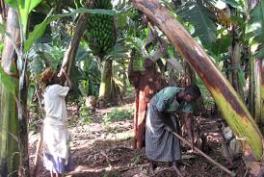
Numerous research institutions and scientists are currently working on developing different Bio- technologies and the African continent is getting itself ready for genetically modified technologies. However, Doctor Charles Lagu from the Mbarara agricultural research and development institute is calling for more sensitization of the farmers to adapt to these technologies if the current efforts are to bear fruits.
It is estimated that by 2050, the world population will increase to 9 billion people and this will increase food demand. The food and agriculture organization of the United Nations (FAO) is predicting that food production will need to increase by 70 percent.

To me, scientists and researchers, embracing Bio technology and genetically modified technology for agricultural improvement is the way to go and we all have a role to play in this.
